
by Guest | Oct 11, 2024 | Being Well, Featured, Uncategorized, Work Well
Let’s face it: Whether you’re a single parent, have a supportive co-parent, or are part of a large, supportive family system, parenting well is hard. Kids, no matter how much we love them, don’t come with instruction manuals and often push us to our limits.
We want to bring our best selves to this parenting endeavor; we know how we treat and invest in our children will have lifelong repercussions . . . but sometimes we need a little support.
Engaging your child resourcefully, creatively, and educationally, boosting and encouraging playful curiosity, and celebrating developmental milestones—that’s what our family educators do every day. We believe that parents are their kids’ first and best teachers and we want to equip parents to engage their kiddos with creative, fun learning activities all year long.
Did you know that year-round support from Healthy Families and Early Head Start is available to families in every part of Tillamook County? Here’s what you need to know about our three Child & Family Programs, all housed under Community Action Team:
Healthy Families:
– Register your child within 90 days of birth
– Known for their diaper program
– Regular home visits, frequency of visits based on need
– Healthy Families – Community Action Team (cat-team.org)
Early Head Start:
– Registration accepted year-round, ages 0-3
– Weekly home visits
– Biweekly socializations/play dates
– Educational and literacy focus
– Seamless transition to Head Start (preschool, ages 3-5)
– www.nworheadstart.org
Head Start:
– preschool (drop off/pick up)
– only available to families living in Tillamook proper at this time
– 2 locations: 1100 Miller Ave, Tillamook, OR and 3808 12th Street, Tillamook, OR
– www.nworheadstart.org
We are a resource for you and want to make your parenting journey a little less
overwhelming, so you can offer your kiddo your very best self!
To reach out and ask questions, please contact:
Christina Pfister
Family Advocate for Early Head Start
971-813-9450
cpfister@nworheadstart.org
Written by Christina Pfister, Family Advocate for Early Head Start
Other wellness questions? Email us at info@tillamookcountywellness.org. For more local health and wellness information, visit www.tillamookcountywellness.org or follow Tillamook County Wellness on Facebook and Instagram.
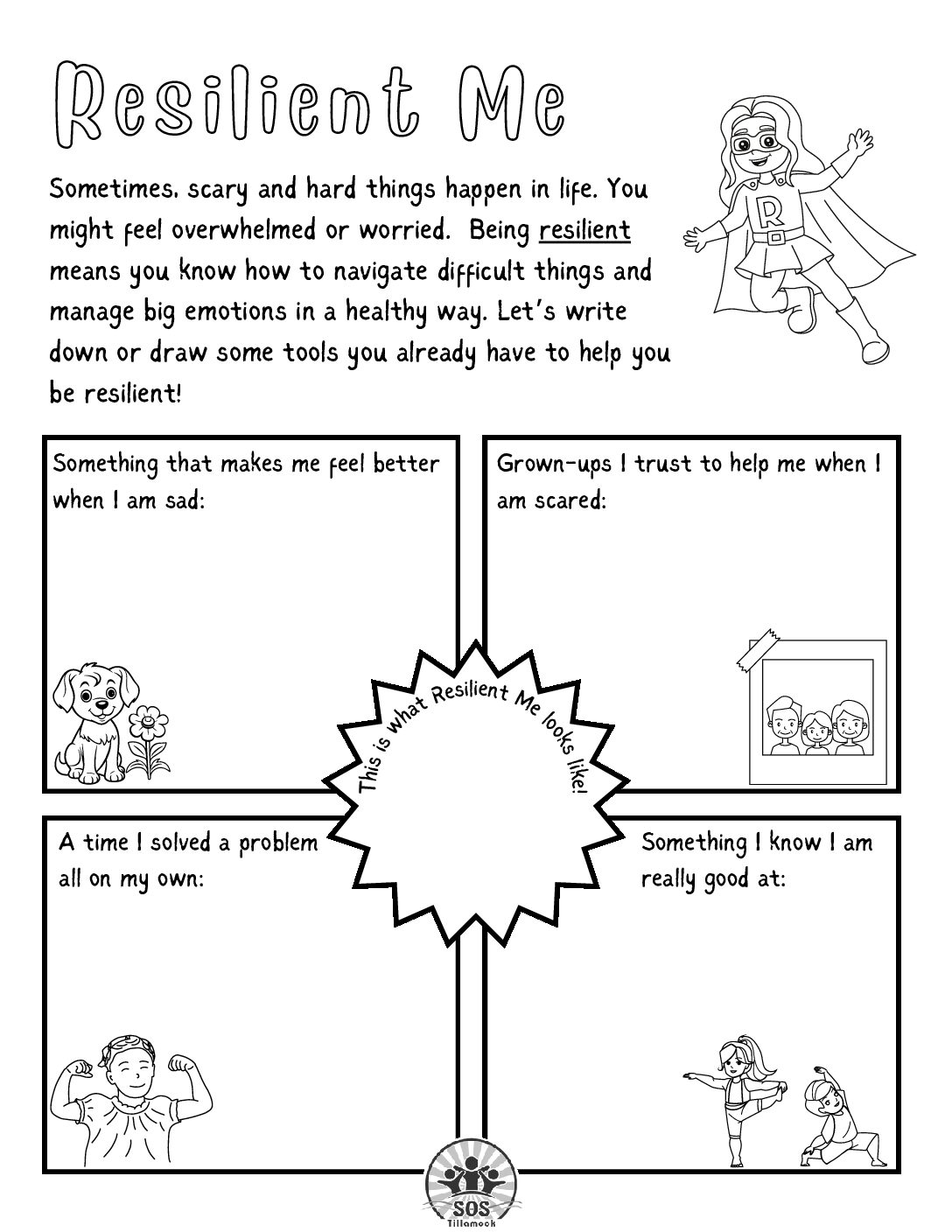
by Guest | Oct 3, 2024 | Being Well, Featured, Uncategorized
Over the last few weeks, I have been reading a great book about addiction*. Preventing addiction is, after all, the core of my work as a Prevention Specialist. One line in particular stuck with me:
“The prevention of substance abuse needs to begin in the crib—and even before then, in the social recognition that nothing is more important for the future of our culture than the way children develop.”
Whether we are talking about addiction, mental health, or any number of other health outcomes, a child’s early development lays the groundwork for their future wellbeing. The notion that a child’s lifelong development is swayed by their earliest years can add a sense of urgency to days that are already strained in time and attention. The good news is that the conversations and daily interactions that parents have with their children are incredibly powerful in building resiliency, and that there are resources right here in Tillamook County to help parents explore what that means. But more on that at the end.
One side of the adolescent-substance-use-prevention coin is directly teaching kids about how alcohol and other drugs are harmful to their health. The Substance Abuse and Mental Health Services Administration’s (SAMHSA) “Talk. They Hear You.” campaign offers information for parents and caregivers on how and when to have conversations about alcohol and other drugs. Though it can feel like children don’t listen, the reality is that parents are among the strongest influences in their child’s decisions around substance use—they do hear you. Consider SAMHSA’s tips on age-appropriate conversations about substances:
- Under age 8: Explain the importance of good health and taking care of their bodies. If they take any vitamins or medications, explain that vitamins are to help them grow and medications are to help them be healthy. However, they should only take vitamins or medications that are given to them by a parent or caregiver, and taking someone else’s medicine could hurt them.
- Ages 8-12: Start asking open-ended questions, like what they have heard about alcohol or drugs. Let them know you are ready to talk if they ever have questions. Use “teachable moments”, like seeing alcohol or substances in movies, ads, or in stores, to explain that these substances are harmful to their bodies and health.
- Ages 13-16: Remember that many teens have peers or friends who may drink or use substances, so be ready to have direct conversations about what they have seen or experienced. Remind them that their brains are still developing until their mid-20s, and that avoiding substances is important to their health and growth. Clearly outline your family rules and expectations about underage substance use.
- Ages 17-20: Maintain clear rules that your child is never to use substances while they are underage or get into a car with a driver who has been drinking or using other drugs. Have conversations about adult responsibilities and decisions, and how they can continue to navigate substances and their health as they become an adult.
The other side of the adolescent-substance-use-prevention coin is, simply put, helping children build resiliency. The ability to manage stress and overcome challenges will serve children for their entire lives. This is certainly easier said than done. Many adults, myself included, struggle to consistently practice heathy ways of coping with stress. Fortunately, parents and caregivers in the Tillamook/Clatsop/Columbia region can take an Active Parenting class for free. This Active Parenting series will teach over 3 sessions: communication, problem-solving, discipline, family enrichment, and encouragement. Active Parenting provides an opportunity for parents to connect, while learning how to make the most out of those daily interactions and conversations with their children, how to pass on resilience, and how to focus on intentional, positive interactions and relationships with our children.
If you want to take advantage of the resources that are available to parents and caregivers, here is how you can find out more:
- “Talk. They Hear You.” webpage: samhsa.gov/talk-they-hear-you/parent-resources
- Active Parenting: The next Active Parenting series will be held on November 7, 14, and 21 from 6:00-7:45pm, via Zoom. To sign up, email MelissaCS@tfcc.org.**
- Parent and Caregiver Resource Workshop: An opportunity to connect with others to learn about and share information on resources available for parents, caregivers & children and why they matter. This workshop will be held on Tuesday, October 8 from 6:00-7:30pm, via Zoom. To sign up, email MelissaCS@tfcc.org.**
- “Resilient Me” is a coloring page for kids to help them identify the tools that they already have to help them be resilient. Download, print, and work through it together!
Be well, and happy fall!
* In the Realm of Hungry Ghosts– for any who are curious. Though first published 17 years ago, the content and propositions have largely stood the test of time.
**Mis is one of the amazing facilitators for Active Parenting, and is an invaluable resource for parenting education here in Tillamook County. Attending her sessions fills the soul!
Written by: Sarah Ermer, MPH, CHES; Prevention Specialist at Tillamook Family Counseling Center
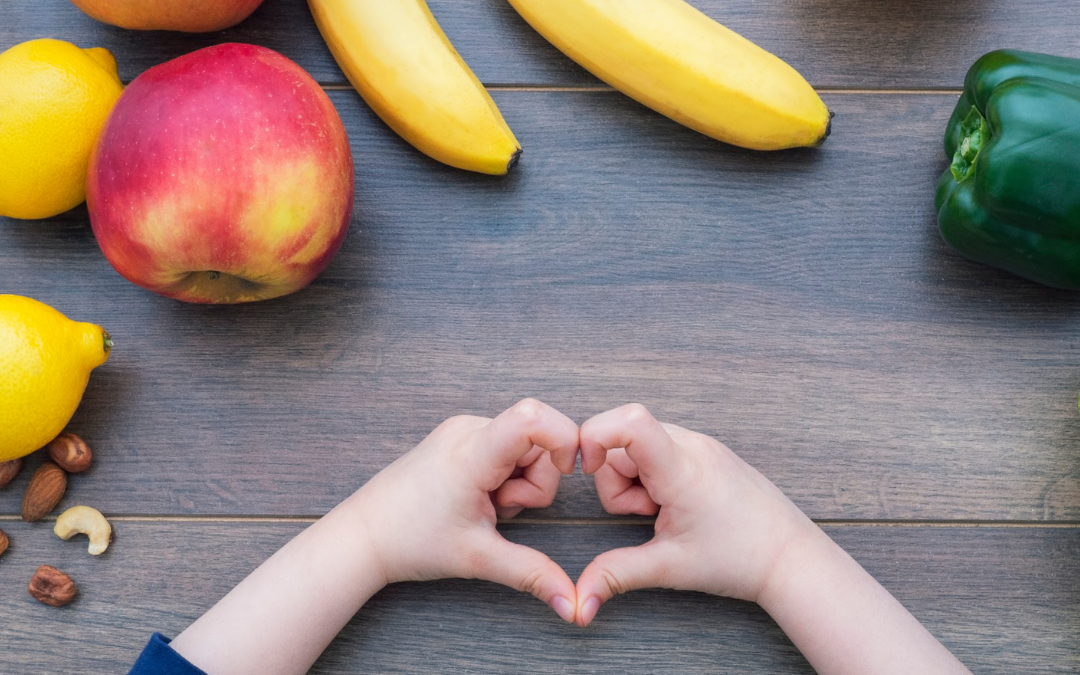
by Guest | Sep 28, 2024 | Being Well, Eat Well, Featured, Lunch & Snack Recipes, Recipes
Healthier Snack Choices: At Home and in the Classroom
At Tillamook County Wellness, we believe that building healthy habits starts at home and continues in the classroom. Teaching children to make better snack choices is a valuable way to support their overall wellness. Here’s how families and educators can help kids make nutritious decisions every day.
At Home: Healthy Habits Start with You
Setting a positive example and providing nutritious options at home can empower children to make healthier choices. Encourage them to reach for snacks like fruits, vegetables, whole grains, and low-fat dairy. Involve your kids in snack preparation to make it a fun and engaging experience. Colorful combinations from different food groups can turn a healthy snack into an exciting treat!
It’s also important to teach children to listen to their bodies and let them decide when they are full. Reading food labels together is another great way to help kids avoid added sugars and unhealthy fats. By developing these skills early on, children will feel empowered to make healthier decisions throughout their lives.
In the Classroom: Creating Healthy Snack Environments
Teachers can play a significant role in fostering healthy habits by bringing nutritious snacks into the classroom. Providing fruits and vegetables as snacks not only encourages better eating habits but also normalizes healthy food choices among peers. Just be sure to check for any food allergies or school rules regarding snacks.
Keep things simple and cost-effective. Something as easy as a few apple slices or colorful bell pepper strips can make a big impact. You can also team up with other parents to provide a nutritious snack, like veggie sticks with ranch dip or a homemade trail mix with dried fruits and whole grain cereals. Working together ensures kids get balanced options at school and at home, helping them form lifelong healthy habits.
Fun and Healthy Snack Ideas:
- Crackers and salsa
- Bell peppers (in different colors)
- Applesauce
- Oranges
- Fruit cups
- Pears
- Tomatoes
- Yogurt
- Trail mix
- Cheese
- Bananas
- Apples
- Cereal bars
For more nutritious snack ideas and resources, check out Foodhero.org
By reinforcing these healthy habits at home and in the classroom, we help children build a strong foundation for their overall wellness. Together, we can create a healthier future for Tillamook County families!
Information for this article provided by Food Hero.
Other wellness questions? Email us at info@tillamookcountywellness.org. For more local health and wellness information, visit www.tillamookcountywellness.org or follow Tillamook County Wellness on Facebook and Instagram.
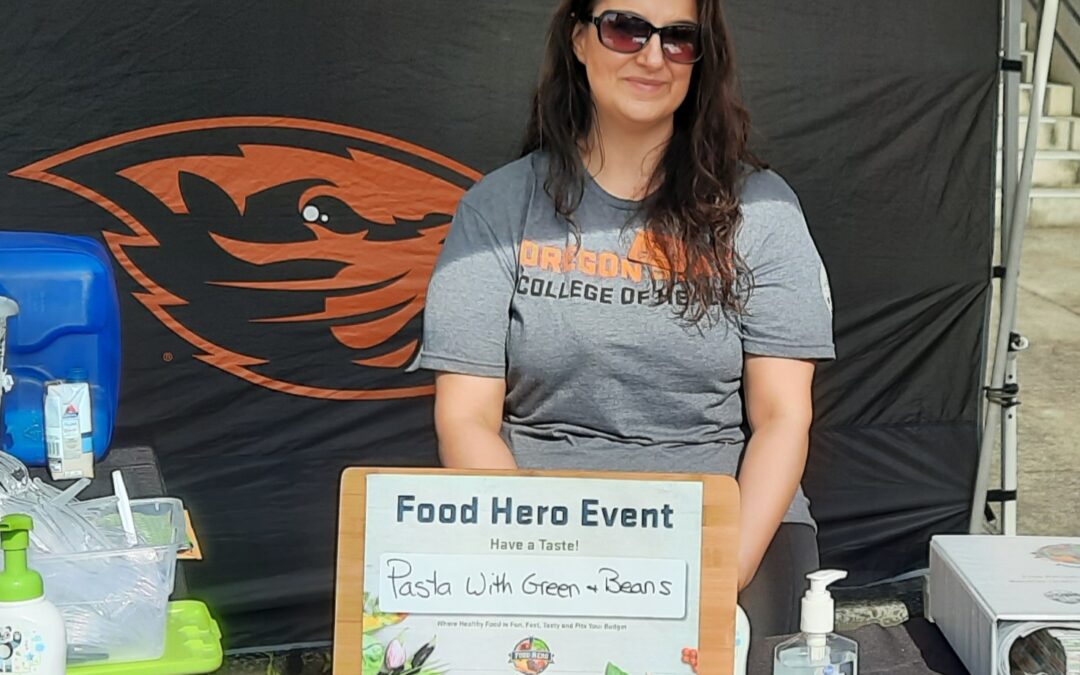
by Guest | Sep 16, 2024 | Being Well, Featured, Why I'm In
“WHY I’M IN …” An interview with Galena Flores, Program Assistant SNAP-Educator with Tillamook County Extension through Oregon State University and Tillamook Family YMCA
What drew you/your organization to partner with Tillamook County Wellness?
My first partnership with Tillamook County Wellness (TCW) was at the YMCA. Having lost my grandfather to diabetes, I became a Lifestyle coach teaching the National Diabetes Prevention Program, which was partnered with Tillamook County Wellness. They promote the program by helping recruit individuals at risk of developing type 2 diabetes. The year-long program taught individuals small lifestyle changes that would have a lasting impact on their health, reducing their chances of getting Type 2 Diabetes.
As my role in the community has changed, I have continued to work with TCW through different avenues and organizations. During my internship at the Tillamook County Community Health Center, I worked with TCW on a Health Literacy campaign that was published on the Tillamook County Wellness Facebook page and other social media platforms.
More recently, with my new role at Tillamook Extension, I have worked closely with TWC on different committees and projects, one of which is the Treasure Your Wellness map currently underway. I am also working with the Access to Physical Activity Committee as we work toward promoting the Salmonberry Trail and events like the bike rodeo and the Four Seasons of Forging events that will be going on in our community throughout the year.
What, if any, changes have you seen come about as a result of this work?
I have seen the prevalence of type 2 diabetes go down in Tillamook, along with the several established walking groups that are throughout the county and much more.
What have you learned from being involved in this work?
This community can do some very meaningful things by bringing different organizations together. I also learned about the Salmonberry Trail, which would be fantastic for our community, along with various other things.
What are your hopes for this work as it relates to you/your organization?
My hope is to empower our community to take control of their health. Through my work with Tillamook Extension, I am providing individuals with the resources and knowledge to be able to make informed decisions about their health. I hope to be able to impact my community with healthy recipes and knowledge about specific ingredients that they might not be sure about. I hope to be able to provide information to people about ways to be more physically active and feel more confident in the kitchen when preparing meals for themselves and their families. I hope to be able to encourage our low-income and underserved population on different ways to take care of themselves, which could be done by teaching them how to prepare nutritious meals with the items they are receiving at the food banks or educating them on different resources there are throughout the community they might not be aware of.
What are your hopes for this work as it relates to changing community health in Tillamook County?
I hope that people will be able to access the resources that my organization and TWC provide. I hope to truly impact our community in a positive way and inspire people to take care of themselves and, if possible, others.
Is there anything else you’d like to share?
TCW truly has its community’s best interest at heart, and many Tillamook County residents do not realize how much they are really affected by this organization. The work that is being done every day to improve this community’s health through different organizations is astonishing. I feel it is a beautiful thing, and we are so lucky to have such a grand coalition in our community.
Other wellness questions? Email us at info@tillamookcountywellness.org. For more local health and wellness information, visit www.tillamookcountywellness.org or follow Tillamook County Wellness on Facebook and Instagram.
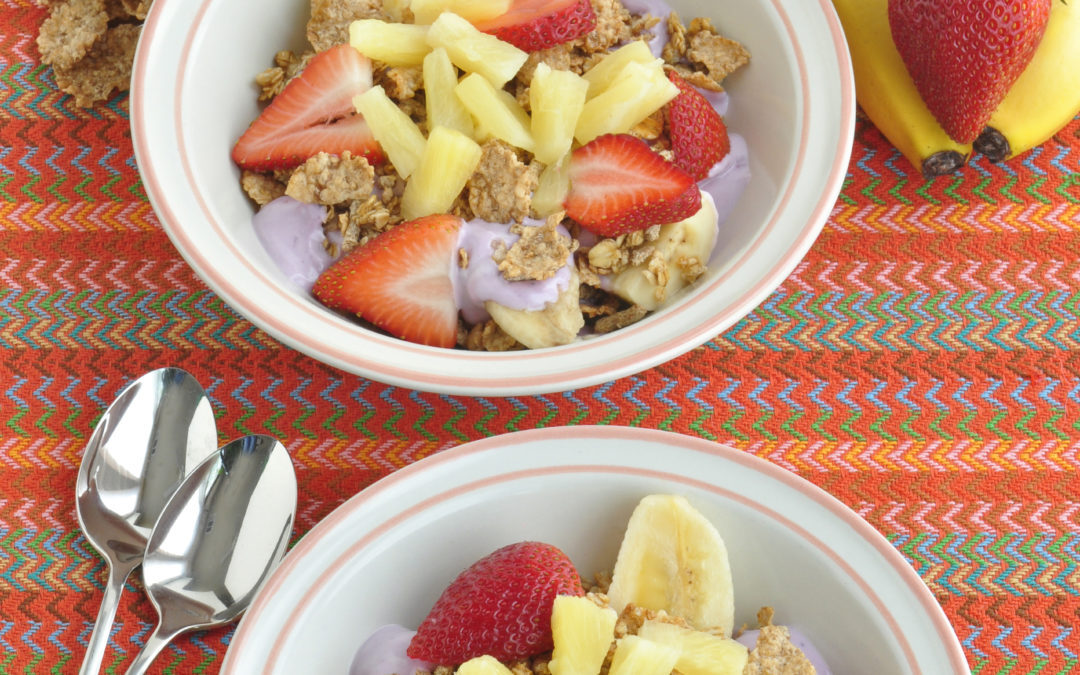
by Renee Aufdermauer | Sep 6, 2024 | Eat Well, Featured, Lunch & Snack Recipes, Recipes
Prep Time: 10 minutes
Ingredients
- 1 banana, cut in half crosswise and again lengthwise
- 1 cup Greek yogurt (plain or flavored)
- 1 cup whole-grain fortified cereal (check the Nutrition Facts label)
- 1 teaspoon honey (optional)
- 1/4 cup sliced strawberries (fresh or frozen)
- 1/4 cup canned pineapple pieces (fresh or canned in 100% juice and drained)
Directions
- Wash hands with soap and water.
- Place 2 pieces of banana next to each other in each of the 2 cereal bowls.
- Over the banana in each cereal bowl, spoon half the yogurt and sprinkle half the cereal. Drizzle with honey, if desired.
- Top with fruit and serve.
- Refrigerate leftovers within 2 hours.
Notes
- Try any fruit, such as blueberries and sliced peaches.
- Look at a cereal’s Nutrition Facts label to see if it is fortified with added nutrients such as B12.
- Use any type of yogurt. Look at the Nutrition Facts label for nutrients of concern such as protein, calcium, saturated fat and added sugars.
Photo & Recipe Source: https://www.foodhero.org/recipes/high-protein-banana-split
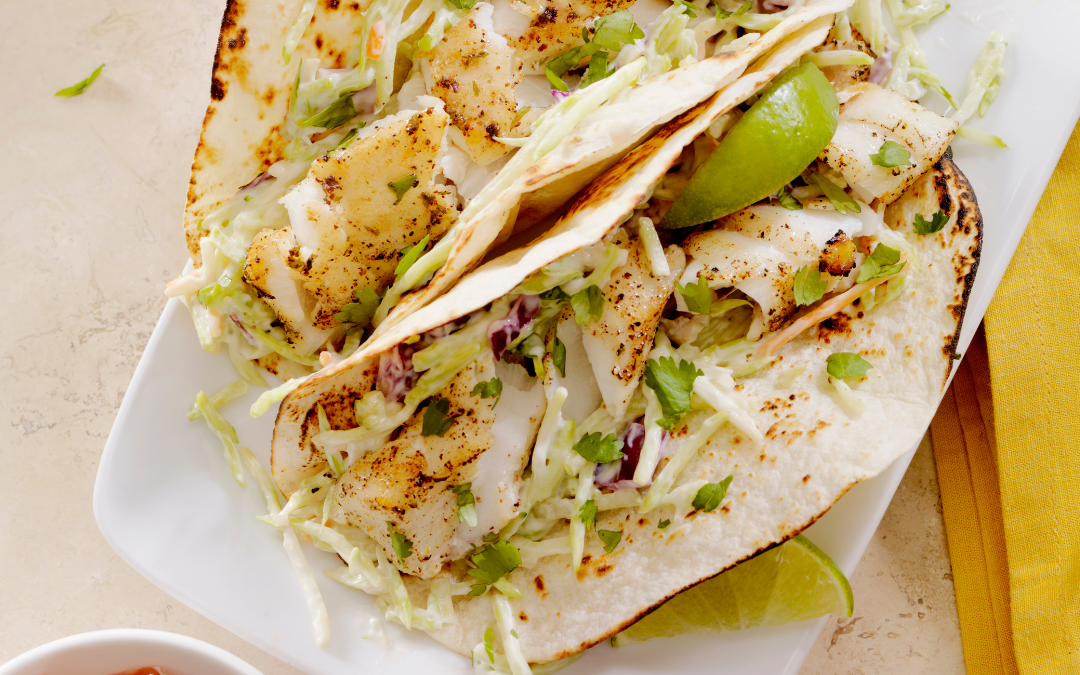
by Guest | Aug 23, 2024 | Eat Well, Featured, Recipes
Looking for a delicious and healthy meal? Fish Tacos are the perfect choice!
Ingredients:
FISH
2 pounds cod fillets
3 Tablespoons lime juice (about 2 limes)
1 tomato, chopped
½ onion, chopped
3 Tablespoons chopped cilantro
1 teaspoon vegetable oil
¼ teaspoon cayenne pepper (optional)
¼ teaspoon black pepper
¼ teaspoon salt
SLAW
2 cups shredded cabbage (red or green)
½ cup chopped green onion
¾ cup nonfat sour cream or plain yogurt
8 corn tortillas (6-inch)
Directions:
- Wash hands with soap and water.
- Rinse or scrub fresh vegetables under running water before preparing.
- Preheat oven to 350 degrees F.
- Place fish in a baking dish.
- In a medium bowl, mix lime juice, tomato, onion, cilantro, oil, peppers and salt. Spoon the mixture on top of fish.
- Cover dish loosely with aluminum foil to keep fish moist.
- Bake 15 to 20 minutes or until fish is opaque and separates easily with a fork. If you have a food thermometer, the internal temperature should reach 145 degrees F.
- For the slaw: In a large bowl, mix cabbage and onion. Add sour cream and salsa; stir until mixed.
- Divide cooked fish among tortillas. Add ¼ cup of slaw to each. Fold over and enjoy!
- Refrigerate leftovers within 2 hours.
Notes
- Freeze extra lime juice to use later.






